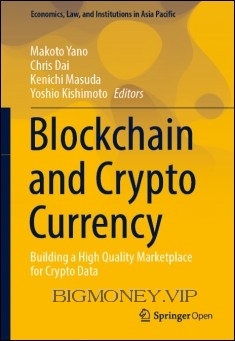Blockchain and Crypto Currency by Makoto Yano, Chris Dai, Kenichi Masuda, Yoshio Kishimoto

Chapter 1
Creation of Blockchain and a New
Ecosystem
Makoto Yano, Chris Dai, Kenichi Masuda and Yoshio Kishimoto
The Japanese Ministry of Economy, Trade, and Industry regards the process of
incorporating new information technology, such as artificial intelligence (AI),
Internet of Things (IoT), and big data analysis into society as the Fourth Industrial
Revolution. This view is reflected in the Fifth Science and Technology Basic Plan.
The plan advocates Society 5.0, in which cyber space and physical space are
integrated to support an affluent and human-friendly society. Computer scientists
regard the interconnection of industry and society through information technologies,
with people creating and using such technologies, as a single ecosystem. They have
actively participated in the design and discussion of such an integrated ecosystem.
Blockchain is considered to be at the core of such a cyber ecosystem.
Terms like the Fourth Industrial Revolution, Society 5.0, and cyber ecosystems
seem colorful and might appear rather farfetched. However, when placed in the
context of the current states of the economy and technological development, one
realizes that the new concepts are rather persuasive. This is because the technological
innovation that is about to start is very unique in the long history of technological
advancement since the First Industrial Revolution.
Today, we are witnessing the introduction of a new type of productive resource into
our economy—data. Data is a new productive resource that had no economic value in
the past. Until a few years ago, there was no way to gather large volumes of data that
could capture daily life accurately, nor were there any computing technologies that
made it possible to analyze an extremely large volume of data to explain complicated
human interactions on both production and consumption sides of an economy. This
has changed all of a sudden.Many productive resources, such as coal and oil, suddenly
became valuable during past industrial revolutions. However, they merely replaced
already existing resources. Coal replaced firewood and charcoal; oil replaced coal.
Data, in contrast, does not replace any existing resources but is born as a completely
new type of productive resource.
In short, industrial revolution in the past meant destroying existing resources and
replacing them with new resources. Sitting in the middle of the Fourth Industrial
Revolution, in contrast, data does not replace any existing resources.
From an economic viewpoint, this difference between past industrial revolutions
and the Fourth Industrial Revolution is large. Previously, the ownership of oil was
assigned to the owner of the land containing the oil, just as the ownership of coal
was assigned before oil was utilized as a major energy source. In the case of data,
we have not established a clear agreement on who owns the data. As Nobel laureate
Ronald Coase (1910–2013) pointed out, the assignment of proper ownership rights
is a prerequisite for the formation of a market.
In these circumstances, blockchain technology opens important avenues to make
efficient and fair use of data. In a broader sense, this technology is also referred to
as a “decentralized ledger,” which can involve a large number of unspecified people
to contribute to the effective and fair use of data in a decentralized manner.
In summary, blockchain is expected to play an important role in connecting infor-
mation technology and technologies such as AI, IoT, and big data with our lives. From
this point of view, this book investigates the roles that blockchain plays in a virtual
ecosystem from various angles, in particular, from the following three viewpoints:
(1) data ownership, (2) data transactions, and (3) data industry.
1 Data: A New Productive Resource
If you are a smart phone user, it must be impossible to think of a day without access to
the Internet. A mechanism to assign unique numbers to various things and integrate
them into the Internet is called the Internet of Things (IoT). Smartphones are all
recognized as IoT terminals, identified by their unique identifiers called telephone
numbers, and, now, play a central role in data storage on the Internet.
With the exception of the phone function, almost all the information acquired
through smartphones is provided through the Internet. At the same time, we have
become an important source of information. Buying goods through Amazon is like
offering part of your household account book. When using Facebook and the “like”
function is used, some sort of preference is expressed toward society. Sending emails
also implies providing information to society.
It is not only humans that can be connected with cyber space through IoT. Com-
puter sensors can be placed on livestock in pasture to keep track of their health and
Blockchain and Crypto Currency by Makoto Yano, Chris Dai, Kenichi Masuda, Yoshio Kishimoto




